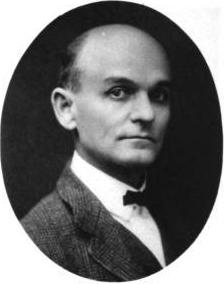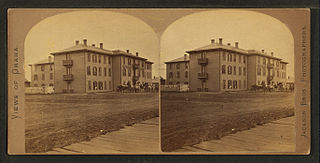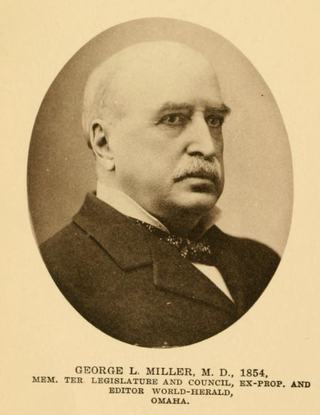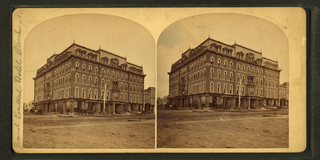
Omaha is the largest city in the U.S. state of Nebraska and the county seat of Douglas County. Omaha is in the Midwestern United States on the Missouri River, about 10 mi (15 km) north of the mouth of the Platte River. The nation's 39th-largest city, Omaha's 2020 census population was 486,051.
Saratoga Springs, Nebraska Territory, or Saratoga, was a boom and bust town founded in 1856 that thrived for several years. During its short period of influence the town grew quickly, outpacing other local settlements in the area including Omaha and Florence, and briefly considered as a candidate for the Nebraska Territorial capitol. Saratoga was annexed into Omaha in 1887, and has been regarded a neighborhood in North Omaha since then.

801 Grand High Rise Building is a 45-story skyscraper in Des Moines, Iowa, United States, operated and managed by JLL Americas and owned by Principal Financial Group. The 801 Grand Building was constructed in 1989 and is the tallest building in Iowa. The building is part of a larger downtown campus run by Principal Financial Group and features a skywalk and an eight-sided copper pyramid at its top.

The Prague Hotel is located at 1402 South 13th Street on the southwest corner of South 13th and William Streets in the heart of the Little Bohemia neighborhood of Omaha, Nebraska. Designed by Joseph Guth and built in 1898, this building was listed on the National Register of Historic Places in 1987.

Downtown Omaha is the central business, government and social core of the Omaha-Council Bluffs metropolitan area, U.S. state of Nebraska. The boundaries are Omaha's 20th Street on the west to the Missouri River on the east and the centerline of Leavenworth Street on the south to the centerline of Chicago Street on the north, also including the CHI Health Center Omaha. Downtown sits on the Missouri River, with commanding views from the tallest skyscrapers.

James Charles Dahlman, also known as Jim Dahlman, Cowboy Jim and Mayor Jim, was elected to eight terms as mayor of Omaha, Nebraska, serving the city for 20 years over a 23-year-period. A German-American and an agnostic, Dahlman grew up in a ranching area and started working as a Texas cowboy. He was elected as a county sheriff and small town mayor in western Nebraska before moving to Omaha.

The Eggerss–O'Flyng Building is located at 801 South 15th Street in downtown Omaha, Nebraska, United States. The building was listed on the National Register of Historic Places in 1991, and named an Omaha Landmark on March 17, 1992.

The Old City Hall, also known as the Red Castle, located in downtown Omaha, Nebraska was located at the corner of 18th and Farnam Streets. Completed in 1890, the building was demolished 1966 after controversy erupted over landmark preservation in the city. Along with Omaha's Old Post Office, the Old City Hall became a rallying call for more deliberate efforts by the community and city leaders.
The Grand Lodge of Ancient, Free and Accepted Masons of Nebraska is one of two governing bodies of Freemasonry in the U.S. state of Nebraska. It was established on September 23, 1857. The Grand Lodge of Nebraska is headquartered at Lincoln, Nebraska.

The Bee Building, later called the Peters Trust Building and finally the Insurance Building, was located at 17th and Farnam Streets in Downtown Omaha, Nebraska. It was an architectural landmark in early Omaha that was built in 1888 by newspaper editor Edward Rosewater to house his Omaha Bee newspaper as well as several other companies. A period review remarked that the building was "probably only second in the United States to that of the New York Herald."

The Cozzens House Hotel, later known as the Canfield House, was a pioneer hotel located at 9th & Harney Streets in downtown Omaha, Nebraska. Constructed in by Union Pacific promoter George Francis Train, the 120-room hotel cost $60,000 to build in 1867. The hotel was widely regarded as the finest hotel between Chicago, Illinois and San Francisco, California when it was constructed.

George Lorin Miller (1830–1920) was an American pioneer physician, editor, politician, and land owner in Omaha, Nebraska. The founder of the Omaha Herald, which later became part of the Omaha World-Herald, Miller arrived in Omaha in 1854, the year the city was founded. He also promoted Omaha as the route of the First transcontinental railroad and the Trans-Mississippi and International Exposition in Omaha in 1898.
The Omaha Driving Park, later called Sunset Driving Park, was located in North Omaha, Nebraska, United States. It was an important recreational and sports venue in the history of Omaha.

Tourism in Omaha, Nebraska, United States offers visitors history, sports, nature and cultural experiences. Its principal tourist attractions are the Henry Doorly Zoo and the College World Series (CWS). A 2003 study by a Creighton University economist estimated that the CWS added $33.8 million to the city's economy that year. With 1.1 million visitors annually, the Henry Doorly Zoo is Nebraska's most popular tourist attraction. In 2007 Omaha hosted the USA Roller Sports National Championships, along with 10,000 people who auditioned for the American Idol television show at Qwest Center Omaha.
William A. Paxton was an American pioneer businessman and politician in Omaha, Nebraska. His life as a rancher and cattleman early in his life, as well as early work with the Union Pacific Railroad was highly regarded among his contemporaries; his success as a businessman later in his life led him to great wealth. His leadership is seen as an essential factor in Omaha becoming a prominent stockyards and meatpacking center. He is frequently referred to as "the real founder of South Omaha."

The Herndon House, later known as the International Hotel and then the Union Pacific Headquarters, was an early hotel located at Ninth and Farnam Streets in present-day Downtown Omaha, Nebraska. Built in 1858 by Omaha pioneer Dr. George L. Miller along with several associates, it was financed by the sale of city-donated land and a $16,000 loan. It was used as the headquarters building of the Union Pacific Railroad for more than 50 years; it was demolished in 1922.
The St. Nicholas Hotel, originally called the Claim House, was located near 12th and Jackson Streets in present-day downtown Omaha, Nebraska. It was the first building in Omaha, the first hotel, and hosted the first church service in Omaha. The Omaha Claim Club met in the building regularly, as well.

The Grand Central Hotel was an early hotel establishment formerly located at 14th and Farnam Streets in downtown Omaha, Nebraska. The Grand Central was built as Omaha's premier lodging after the Herndon House became the Union Pacific Headquarters.

The former Woodmen of the World Building in Omaha, Nebraska, was located at 1323 Farnam Street. Built in 1912 by the architectural firms of Holabird & Roche and Fisher and Lawrie, the building was the headquarters of Woodmen of the World (WOW) from 1912 until 1934. WOW relocated in 1934 to the Bee Newspaper Building at 17th and Farnam, also known as the Insurance Building.















